One of the best ways to join two or more wood pieces together, edge-to-edge, face-grain to face-grain or edge-grain to edge-grain is by using using a biscuit joiner tool.
The biscuit joiner also known as a plate joiner, cuts an oval-shaped slot into the faces of the wood to be joined and a thin wooden or plastic disc called the biscuit is covered with wood glue and inserted into the slot. Both wood pieces are then clamped together to create the joint.
Here in this article I’ve reviewed and listed 6 of the best biscuit joiners you can find in the market to carry out your projects. But before that, here’s why I think you should have it in your tool arsenal.
Our Top Picks
Makita XJP03Z | Dewalt DW682K | WEN JN8504 |
Best Cordless | Best Electric | Best Budget |
|
|
|
Table of Contents
Why Use a Biscuit Joiner or Joinery
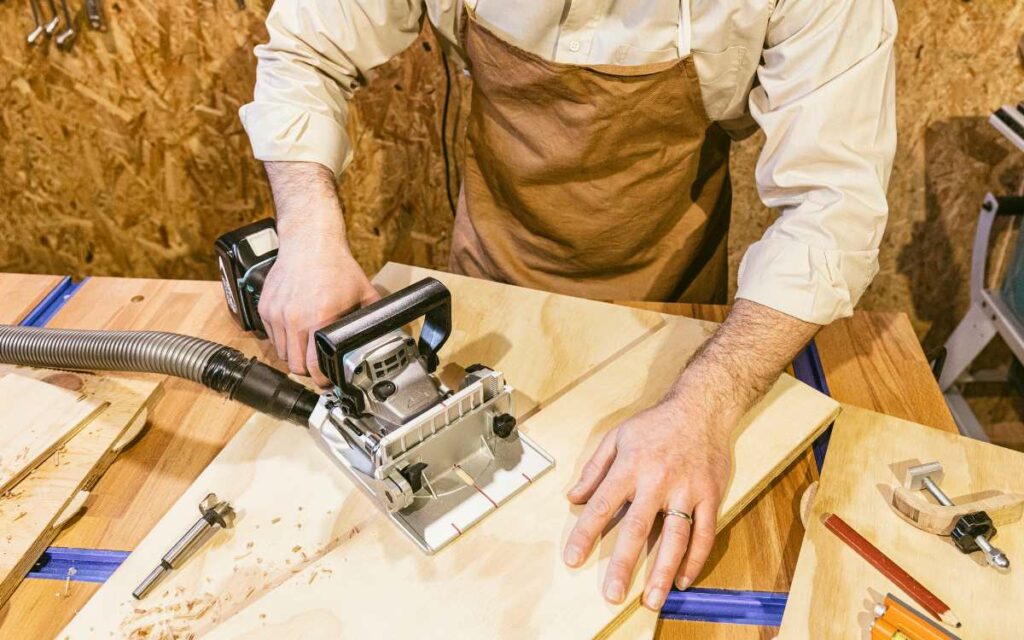
Although some woodworkers argue that it’s not an important tool to have, I think it’s very handy. I use it for 3 main reasons, which are: Alignment, Stability and Appearance.
When making a tabletop, most of the time you have to glue several boards together edge-to-edge to form the tabletop. If you’ve done this before, you’ll know that aligning the several pieces of boards during the glue-up can be quite difficult and time consuming.
With a biscuit joiner however, you can cut slots into the sides of the boards, add the biscuits and align them easily during the glue-up.
When you carry out the glue-up like this, you end up with a tabletop that’s perfectly aligned, very stable due to the additional biscuits in the joints, and looks very neat because the biscuits are well hidden after the glue-up.
So, if you’ve been having issues aligning the boards when gluing your tabletops, using a biscuit joiner will surely make it easier.
Like I mentioned earlier, I also use the joinery because of its appearance. Unlike dowels which can be visible in some cases, biscuits are always hidden inside the joint, so the final result always looks clean and seamless, since there’s no visible fastener.
When To Use It

Biscuit joiners has several applications in the workshop.
Aligning and Strengthening Tabletops:
I have already talked about this above. It makes it easier to align and make wide tabletops with strong and precise, invisible joints.
Cabinet and Furniture Making:
If you’re a furniture or cabinet maker, using a biscuit joiner can help you make clean, professional-looking cabinets and furniture pieces. You can use it to join the top, sides and base of the cabinets, and because the biscuits are hidden, the resulting joint looks clean and seamless.
There are many other areas you can use it such as when making picture frames, and molding installation. You just have to use your imagination and use it when necessary.
The following are 6 of the best options you can use for your projects.
1. Dewalt DW682K Biscuit Joiner Kit
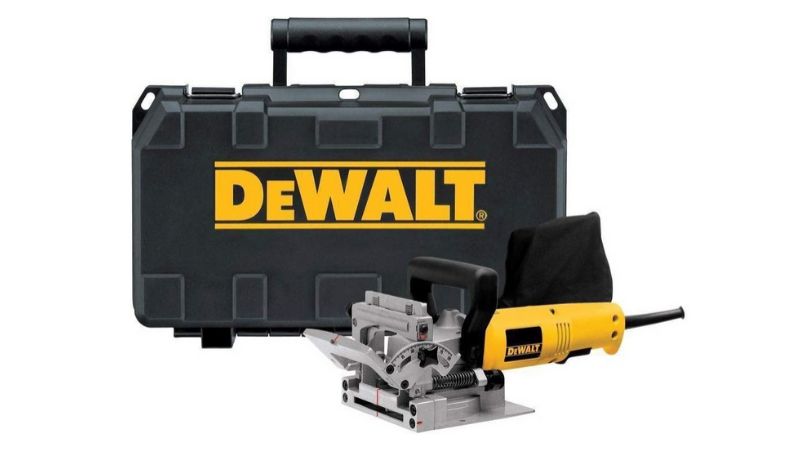
Specifications
Motor Speed: 10,000 RPM, Blade Size: 4 inches, Motor Amps: 6.5 amps, Biscuit Size: #0, #10, #20, Weight: 6.6 lbs.
Equipped with a powerful 6.5 Amps motor which spins at a speed of 10,000 rpm, the Dewalt DW682K biscuit joiner is capable of cutting through any wood you’re working with, hard or soft.
It comes equipped with a dual rack and pinion fence system which ensures that the blade and fence are parallel so that you can make accurate repeated joints every time.
You can adjust the fence from 0 to 90 degrees easily to make any type of angled cut you want to make.
A notch exists in the 45 degree angle which makes cutting slots for miter joints very easy.
On the 0 degree angle you can make flush cuts without removing the fence, and there are positive depth stops for all the common biscuit sizes you can use for making the joints.
The non-marring heavy duty aluminum shoe allows the Dewalt DW682K biscuit joiner to be used even on delicate projects.
Pros
Cons
2. Porter Cable Plate Joiner Kit

Specifications
Motor Speed: 10,000 RPM, Blade Size: 4 inches, Motor Amps: 7.0 amps, Biscuit Size: #0, #10, #20, Weight: 7.5 lbs. Type: Corded electric.
With the Porter Cable plate joiner, you have a reliable tool you can use to cut slots for your biscuit joints through any kind of wood.
It comes equipped with a power 7 amp motor which rotates the blade at a speed of 10,000 rpm.
You can tilt the fence from 0 degrees to 135 degrees easily to make any type of angled biscuit joint.
It comes with two blades. A 4 inch blade for making standard sized cuts and a 2 inch blade for making finer cuts up to 1-1/2 inches.
The porter cable biscuit joiner has seven different cutting settings you can use to make your cuts, and a seven-position rotating depth stops for the different sizes of biscuits you can use for making the joints.
It’s portable and easy to handle, weighing just 7.5 lbs and measuring just over 7 inches in height.
Pros
Cons
3. WEN JN8504 Biscuit Joiner
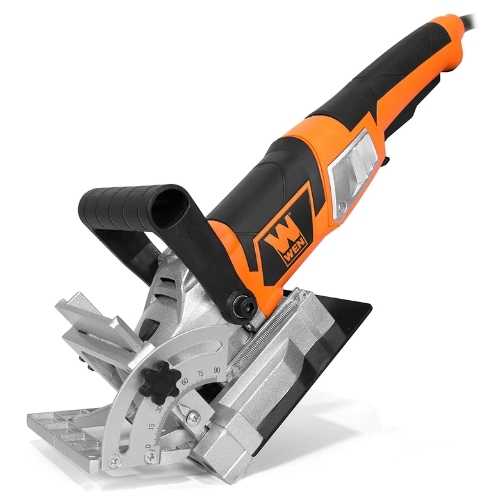
Specifications
Motor Speed: 10,000 RPM, Blade Size: 4 inches, Motor Amps: 8.5 amps, Biscuit Size: #0, #10, #20, Weight: 7.3 lbs. Type: Corded electric.
The plate and biscuit joiner with model number JN8504 from the WEN is one of the most sought after power tool for making biscuit joinery.
It comes equipped with an 8.5 am motor powering a 4 inch carbide-tipped blade. The blade spins at a speed of 10,000 revolutions per minute, allowing quick, clean and precise cutting of slots, even through hardwood for insertion biscuits.
The WEN JN8504 also features a height and angle adjustable fence, which means slots can be cut at any height and angle, making it suitable for different sizes of workpieces.
The blade is adjustable with present stops for creating sluts for #0, #10 and #20 biscuit sizes. It can also be manually adjusted to cut other slot sizes depending on the size of biscuits you have.
Whether, you’re edge-joining panels, aligning boards or strengthening different types of joints, this plate joiner from WEN will work just fine.
It will work fine for strengthening miter joints, T-joints, corner joints, edge-to-edge joints, offset joints and more.
Included is a detachable dust bag to help contain the dust produced when using the tool, and it also comes with 24 #20, 16 #10 and 10 #0 wood biscuits to help kick start your project right away.
Pros
Cons
4. REXBETI
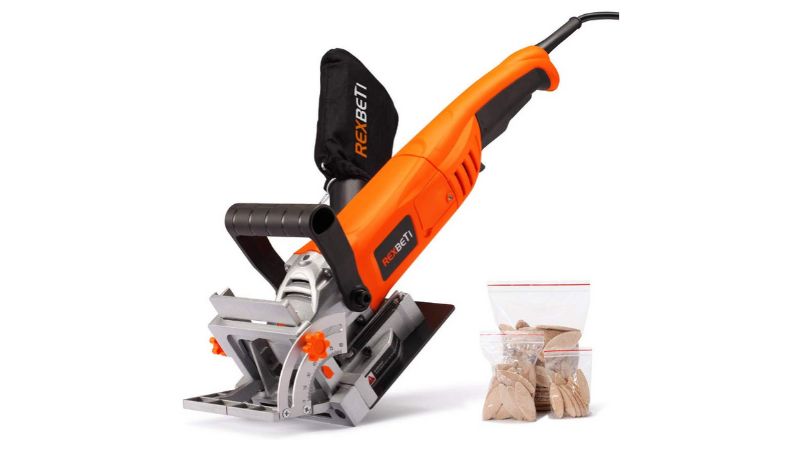
Specifications
Motor Speed: 10,000 RPM, Blade Size: 4 inches, Motor Amps: 8.5 amps, Biscuit Size: #0, #10, #20, Weight: 7.0 lbs.
One of the best biscuit joiners you can use to make biscuit joints during your woodworking projects is the REXBETI REX031.
It weighs just 7 lbs. making it very portable and easy to handle. With a powerful motor producing a no load speed of 10,000 rpm, you have a very powerful tool you can use no matter the type of tool you’re working with.
The REX031 comes equipped with a 4 inche blade and it has a cut depth capacity of 15 mm.
As for the fence, it can be adjusted from 0 to 90 degrees and it’s suitable for making biscuit joints no matter the type of joint or angle with which you want to make the joinery.
There are stops at 0 degrees, 45 and 90 degrees respectively, to ensure ease of cuts at commonly used angles.
Pros
Cons
5. Makita XJP03Z 18V Cordless Biscuit Joiner
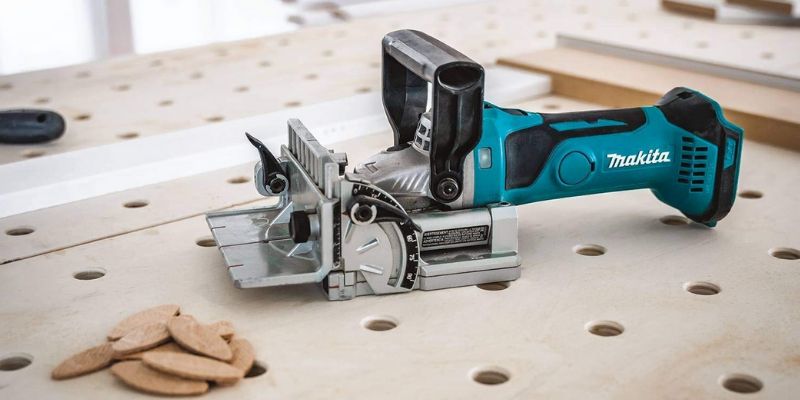
Specifications
Motor Speed: 12,000 RPM, Blade Size: 4 inches, Battery: 18V Lithium-ion, Biscuit Size: #0, #10, #20, Weight: 6.7 lbs. Type: Cordless.
If you want a cordless biscuit joiner you can work with on the jobsite without the inconvenience of using a cord, then you should consider getting this Makita XJP03Z.
With it you can cut slots for the different sizes of biscuits, and there are preset depth stops for making these cuts.
The XJP03Z comes equipped with a rack and pinion vertical fence system which you can use to make accurate adjustments for the joints you want to cut.
Pros
Cons
6. VonHaus

Specifications
Motor Speed: 10,000 RPM, Blade Size: 4 inches, Motor Amps: 8.5 amps, Biscuit Size: #0, #10, #20, Weight: 7.4 lbs Type: Corded electric.
Equipped with a hard 4 inch tungsten carbide tipped blade, the VonHaus 8.5 amp biscuit plate joiner offers one of the best solutions you can use for cutting slots for your biscuit joints.
The adjustable fence allows you to set it at different angles and cut the slots easily, and there are preset depth stops for cutting slots for commonly used sizes of 0, 10 and 20 accurately.
A large ergonomic top handle makes it easy to handle it comfortably even if you work for a long time with it.
Pros
Cons
How To Choose the Right Biscuit Joiner

A biscuit joiner is not a very complicated tool, so choosing the right one is not really that complicated if you know what you want.
Most of the time, in this type of scenario, the deciding factor is most likely the brand you favor.
As long as the one you’re looking at is not from far back as the 1960’s, most modern biscuit joiners does the job pretty well. They cut snug and tight-fitting slots pretty easily.
What I’ll look at though, apart from the brand and pricing, is the amount of power or the motor amperage and rpm of the different ones available.
This will tell you how much power it produces and how much work you can do with it at a time.
You should also decide whether you need a corded model or a cordless one. A cordless unit is usually more expensive than a corded one because it’s more portable. You can literally take it with you anywhere without worrying about a power source.
As for dust collection, all the ones I’ve seen come with a pretty decent dust bag and a dust port that extracts the dust.
Depth and bevel adjustment should also be considered. There are different sizes of biscuits you can use for your joints. That’s why the depth of cut and bevel angle are adjusted based on the size of biscuits you’re using and the type of joint being made. All the joiners reviewed in this article have depth stops for the most common sizes of biscuits available like the #0, #10 and #20, so the slots can be cut easily and efficiently.




